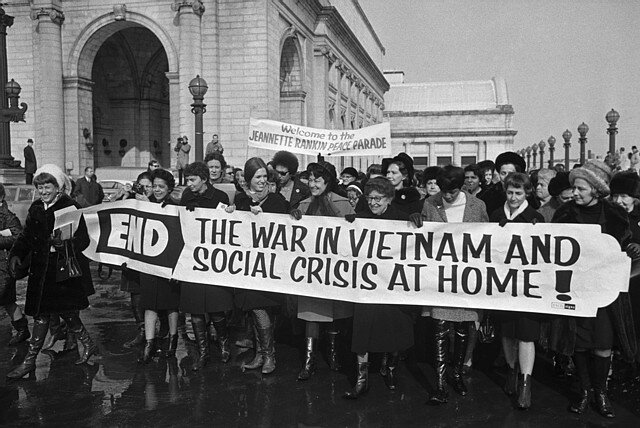The Impact of 1960s Counterculture Movement in the 1970s New Hollywood Era: A Review of the Literature
From the Vietnam War, Civil Rights Protests, political assassinations, and the moon landing, it’s safe to say that the 1960s was one of the most influential decades that the United States has ever seen. And with the birth of these historical monuments came the birth of another set of ideals and interests: the counterculture movement. The American Counterculture Movement of the 1960s had a direct impact on the cinema that was produced during the 1970s; the rise of the New Hollywood Era of filmmaking. Seventies cinema was an artistic reflection and reaction to sixties circumstances. Because the counterculture movement impacted a young and impressionable group of people, including many film students, this was manifested in auteurist filmmakers who pushed boundaries of how films could be made, what stories could be told, and how to get their films into the public eye. This paper will be divided into three sections. The first section will explore the origins and extent of the counterculture movement. The second section will cover what made films of the seventies different than any other decade before. And the last section will examine why cinema of the seventies is so impactful to the art of filmmaking.
Origins and Extent of the Counterculture Movement
The events and circumstances that happened during Counterculture Movement would later be reflected in seventies cinema.The Counterculture Movement started in the early sixties and was an anti-establishment cultural movement in Western civilization that spurted new groups of people who opposed the “all-American” ideals such as commercialism, capitalism, the Vietnam War, the overall institution of societal standards, and most specifically the norms of the 1950s. Some of the most well known counterculture groups include “hippies'', feminists, anti-war activists, and civil rights campaigners. Larkin (2015) emphasized the importance of this cultural phenomenon, and the key relationship between how social movements and counterculture work together to propel new ideas into society. An important role of the counterculture movement was how peaceful protest was used as a tool to vocalize a yearn for change within society, which we can see reflected in cinema made in the decade to precede this movement. So many of the peaceful protestors of the counterculture movement were college students, and many were film students whose participation in the counterculture movement would be reflected in their art in the years to come. Not only was conflict arising in the streets for social issues like the Vietnam War and the Civil Rights Movement, it was also happening in a different way out west in Hollywood, California.
All the changes made in society through the 1960s led to changes in the film industry as well. Although film censorship had been a chronic trademark of the motion picture industry since its beginnings, by the 1960s, court rulings strongly curbed government infringement. However, there was still an iron curtain of statewide regulations that lasted through the 1980s. Films like Alfred Hitchcock’s 1960 box office hit, Psycho, set an important precedent at the beginning of the decade because the popular film was released without a certificate of approval for its themes, which greatly invalidated the jurisdiction of the Motion Picture Production Codes. Gruner (2019) concluded that these loosening censorship laws paved the way for a new focus on screenplay development and “superannuated hippie leprechaun” writers such as Waldo Salt, the penman behind Midnight Cowboy (1969). Without the Psycho precedent, Salt might not have been able to write a film as bold as Midnight Cowboy. These relaxing codes allowed screenwriters to write about subjects that would have never been approved by the Motion Picture Association (MPA) before this era of Counterculture, which we can see truly blossom in the “New Hollywood Era” of moviemaking.
What makes Seventies Cinema Different from Previous Decades
The New Hollywood Era is one of the most important ways we see what makes the seventies stand out amongst the decades that preceded and followed it. The New Hollywood Era is also referred to as the American New Wave or the Hollywood Renaissance. The era is defined by a new generation of young American filmmakers, many of which were film students during the counterculture movement. They are often jokingly referred to as “movie brats”. These filmmakers were auteurs, writing and directing their own vision. Notable auteurs of the seventies include George Lucas (Stars Wars: A New Hope), Steven Spielberg (Close Encounters of the Third Kind), Martin Scorsese (Mean Streets), Peter Bogdanovich (The Last Picture Show), and Francis Ford Coppola (The Godfather). To fully understand the American New Wave movement, it’s essential to know where these young filmmakers got their inspirations, and it’s largely from previous international New Wave movements like the French New Wave of the 1950s and more notably Italian Neorealism of the 1940s, the subjects that these filmmakers studied while in film school. These “New Wave” movies often had more complex themes like sex and violence. In the American New Wave we see a rise in themes that include sex and violence as well a growth in the antihero protagonist in popular films like One Flew Over the Cuckoo’s Nest (1975) and Dog Day Afternoon (1975). Moore (2018) argued that part of what made these auteurs distinct was how they normalized using sound design and production in unconventional ways. Their unorthodox techniques spanned from the actual screenplay all the way to the technicalities of filmmaking, which is why they sought to work outside of the Hollywood Studio system which led to the creation of a new media capital in the United States, San Francisco, California. San Francisico became a place where boundaries in filmmaking could be pushed and flourish. By the time the 70s rolled around, the studio system was already falling apart, and with studio censorship laws of 60s beginning to be phased out, there was a notable change in the films released in this next decade.
Not all films made in the seventies were created equal. In fact, in this decade we can see a distinct separation between types of films; high and low concept. High concept films are films that can be described by a distinctive and succinct premise, and low concept films are films that put a focus on the society and people within the plot itself. Wyatt (1996) established through using “high concept” film, Grease (1978), and “low concept” film, All That Jazz (1979) as examples that high concept films were usually big budget, had “star power”, and were more often box office successes. Important high concept cinema include Jaws (1975) and Star Wars (1977). But surprisingly it’s often the lower concept films that society remembers as tokens of the New Hollywood Era. These films were frequently gritty, had a modest budget, and original stories; like nothing audiences had seen before. Important low concept cinema of the seventies includes the iconic Saturday Night Fever (1977) and Annie Hall (1977). This generation of New Hollywood film students turned auteurs led to more experimental films with unknown actors and low budgets. And with the loosening of government censorship, these films could be made.
Impact of Seventies Cinema
Seventies cinema set a precedent and left a major impact on the film industry and the Hollywood system as a whole, forever. Through artistic protest against censorship, how films were made, and the characters and themes that could be displayed on the silver screen, the American Renaissance bridged a gap between the film industry and their audience. Allen (2005) argued that two distinct characters shown most notably in this era of cinema, cowboys and hippies, aren’t much different from each other, and from the audience as well. Cinema that focused on cowboys and hippies also dealt with issues of leftism, the “Myth of the West'', and the counterculture movement of the 1960s, which were relatable American movie goers as well. Throughout history, movies have been used and seen as an escape from reality. In the seventies it was still used in that way, but the characters shown were relatable to their audiences in ways that weren't immediately clear to spectators. Most people going to movie theaters weren't wild cowboys or raging hippies, but these characters were made relatable by being shown in situations that were prevalent of the counterculture movement. An example of this can be seen in Peter Bogdanovich’s The Last Picture Show (1971). While most viewers of this film aren’t high school seniors who live in a dead end cowboy community, the ongoing theme of what their future will look like is relatable to many, even the “hippies” out in the audience. Part of what makes the seventies so impactful is the way that filmmakers brought real life issues and relatable people onto the big screen, which would forever change the stories that get told in the movie theater.
The 1970s was a creative rebirth for Hollywood. The New Hollywood Era started patterns in all aspects of the Hollywood industry, from the way business, art, and ideas were supervised. According to Elsaesser, Horwath A, and King (2004), we are living in the shadow of “a Golden Age and a closed chapter of history” and that the impact of New Hollywood is superior to all. Not only can we witness it through the films themselves, but we can see it in patterns of neoconservative discourse in the United States, and the birth of new cinematic genres. The 1970’s was a daring and inspiring time for Hollywood, many claim that every film that was released after this era of is living in the shadow of the golden age of cinema.
Conclusion
The culmination of the articles referenced in the previous sections of this paper analyzed the importance of the Counterculture Movement on the American Renaissance that took place in the 1970s. Factors like the origins and extent of the Counterculture Movement, what made the movies of the 70s unique, and the impact of 70s cinema in decades to come all combine efforts to show how restrictions can create impactful art. Hollywood in the 70s started in a financial and artistic depression, but the loosening restrictions on language, sex, and adult content as a whole led to the creation of some of the most important films ever made.
The research I have found on this topic is extensive and specific. However, the research done in this field of study tended to be extremely niche; zeroing in on specific films, artists, and time periods. While the research analyzed above is extremely interesting and useful in certain fixed circumstances, I believe that further research should be conducted in a broader consciousness to be able to identify the big patterns and relationships between Counterculture and the New Hollywood Era in a tighter manner.
College professors and film students can make use of this research to become more conscious of the close relationship between 60s Counterculture and 70s cinema. This information can also be used by aspiring filmmakers and cinephiles to properly educate themselves on the people who made an impact on the industry prior to them. After all, if this research is utilized fittingly, it could inspire the next generation of young creatives.
References
Allen M. (2005) "I just want to be a cosmic cowboy": Hippies, cowboy code, and the culture of a counterculture.
Western Historical Quarterly, 36(3), 275-802
Wyatt J. (1996) High Concept: Movies and Marketing in Hollywood.
Texas Film Studies Series 1(1), 1-22
Elsaesser T. & Horwath A. & King N. (2004) The impure cinema: new hollywood 1967-1976
The Last Great American Picture Show, 9-17
Gruner O. (2019) ‘Hippie Superannuated Leprechaun’: Waldo Salt, Screenwriting and the Hollywood Renaissance.
Historical Journal of Radio, FIlm, and Television, 39(2) 1-32
Andriano-Moore S. (2018) The Rise of the Sound Designer: Northern California Film Sound in the 1960s and 1970s
Historical Journal of Radio, FIlm, and Television, 38(3) 1-19
Larkin R. (2015) Counterculture 1960s and beyond.
International Encyclopedia of the Social and Behavioral Sciences: Second Edition











